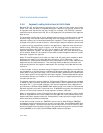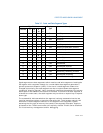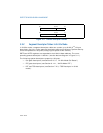
Vol. 3 3-15
PROTECTED-MODE MEMORY MANAGEMENT
store its own data, such as information regarding the whereabouts of
the missing segment.
D/B (default operation size/default stack pointer size and/or upper bound)
flag
Performs different functions depending on whether the segment
descriptor is an executable code segment, an expand-down data
segment, or a stack segment. (This flag should always be set to 1 for
32-bit code and data segments and to 0 for 16-bit code and data
segments.)
• Executable code segment. The flag is called the D flag and it
indicates the default length for effective addresses and operands
referenced by instructions in the segment. If the flag is set, 32-bit
addresses and 32-bit or 8-bit operands are assumed; if it is clear,
16-bit addresses and 16-bit or 8-bit operands are assumed.
The instruction prefix 66H can be used to select an operand size
other than the default, and the prefix 67H can be used select an
address size other than the default.
• Stack segment (data segment pointed to by the SS
register). The flag is called the B (big) flag and it specifies the
size of the stack pointer used for implicit stack operations (such as
pushes, pops, and calls). If the flag is set, a 32-bit stack pointer is
used, which is stored in the 32-bit ESP register; if the flag is clear,
a 16-bit stack pointer is used, which is stored in the 16-bit SP
register. If the stack segment is set up to be an expand-down data
segment (described in the next paragraph), the B flag also
specifies the upper bound of the stack segment.
• Expand-down data segment. The flag is called the B flag and it
specifies the upper bound of the segment. If the flag is set, the
upper bound is FFFFFFFFH (4 GBytes); if the flag is clear, the
upper bound is FFFFH (64
KBytes).
Figure 3-9. Segment Descriptor When Segment-Present Flag Is Clear
31
16
15
13
14 12
11
8
7
0
0
Available
D
P
L
TypeS
4
31
0
Available
0
Available


















